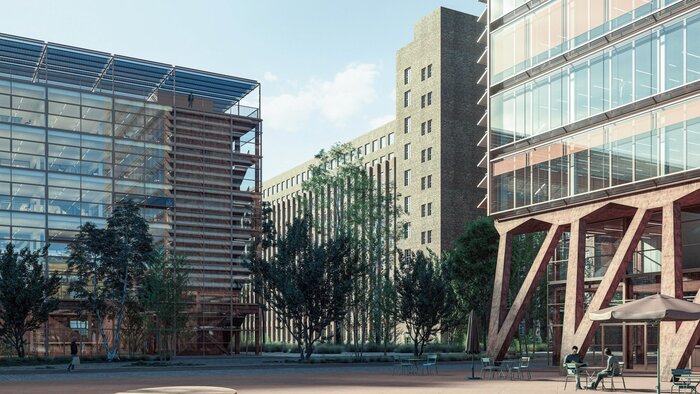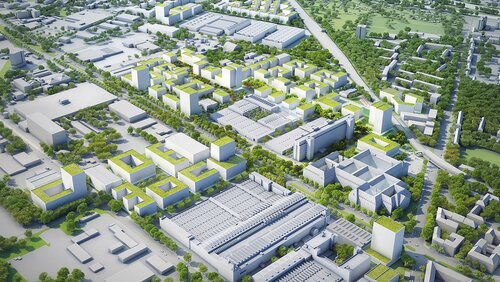Quarters & Developments
Siemensstadt2, Berlin
Siemens Real Estate, Munich
08/2019 – 2030
Robertneun Architekten, Berlin
1 Mio. m²
430,000 m², of which listed: 230,000 m²
600 million € gross
Siemensstadt2 is being built on a historic industrial site in Berlin. Drees & Sommer is advising and supporting the flagship neighbourhood with certification based on two sustainability systems. With a record-breaking 93 out of 110 points, Siemensstadt2 achieved the "Platinum" level in the new LEED for Cities and Communities at the end of 2020. The result according to DGNB Quarters 2020 arrived a few weeks earlier and was no less excellent with 84.1 per cent "Platinum". This first double award marked the end of a successful year for the Berlin neighbourhood project. Drees & Sommer has been supporting the project since 2019, with the neighbourhood and sustainability experts advising the client on all sustainability issues, working with them to develop the key sustainability guidelines and KPIs for the overall project and providing qualified certification advice, followed by pre-certification in accordance with DGNB and LEED. The team is currently in the starting blocks for the individual building certifications in the first construction phase.
With a total area of more than 70 hectares, of which around 45 hectares are to be redeveloped, Siemensstadt2 is one of the largest urban development projects in the north-west of Berlin. The development is taking place "step by step" and Siemens is thinking internationally in terms of future partners. The decision was therefore made early on not only to rely on the German DGNB system, but also to apply the LEED for Cities and Communities system, which has been in existence since 2018, in order to check the planning and take the project to the next level in terms of quality.
The client's core idea is to realise a smart district at the industrially characterised home location that is operated in a CO2-neutral manner. Among other things, this will offer over 2,500 new flats, thousands of jobs and around one million square metres of gross floor space. The revitalised Siemensbahn line and a low-car inner ring road form the backbone of the district's sustainable mobility strategy.
In terms of energy, the neighbourhood focuses on efficiency, photovoltaics on roofs and façades, a low-ex network fed by geothermal energy and, of course, the coupling of the mobility, energy generation and building sectors. The masterplan also aims to create a (precipitation) runoff-free neighbourhood in order to become even more climate-resilient. To minimise overheating at the site, roofs and façades will be greened and outdoor areas upgraded. And, of course, the site is set to become one of Berlin's smart locations of the future: with Siemens IoT, various digital twin solutions for planning and operation and many other innovations.
Leistungen
- Sustainability planning
- BCD neighbourhood certification
Added value
- Experience in certification enabled the LEED for Cities and Communities system to be adapted quickly
- Comprehensive expertise in sustainability planning
 © Siemens
© Siemens © Siemens
© Siemens © Siemens
© Siemens © Siemens
© Siemens © Siemens
© Siemens